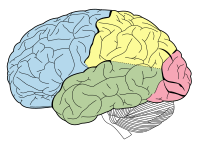
Photo from wikipedia
Brain–computer interface systems help paralyzed people to control devices such as a computer cursor, robotic limbs, wheelchairs, or spellers by only using their thoughts. Nowadays, electroencephalogram (EEG) signals are mostly… Click to show full abstract
Brain–computer interface systems help paralyzed people to control devices such as a computer cursor, robotic limbs, wheelchairs, or spellers by only using their thoughts. Nowadays, electroencephalogram (EEG) signals are mostly used to detect activity of various actions within the brain as they provide rich information about brain’s electrical activity. However, EEG signal generates large amount of data which is usually difficult to interpret and classify. This paper introduces a new classification strategy based on EEG signals, which is called fuzzy-based classification strategy (FBCS). FBCS minimizes the classification time by perfectly extracting the effective features of the produced EEG signals based on a set of elected electrodes using semantic analysis, then taking the classification decision accordingly. FBCS uses feature reduction and electrode selection techniques to reduce the dimensionality of data to be classified, which also improves the classification accuracy. Experimental results have shown that FBCS outperforms recent classification strategies in terms of accuracy and classification time.
Journal Title: Soft Computing
Year Published: 2019
Link to full text (if available)
Share on Social Media: Sign Up to like & get
recommendations!